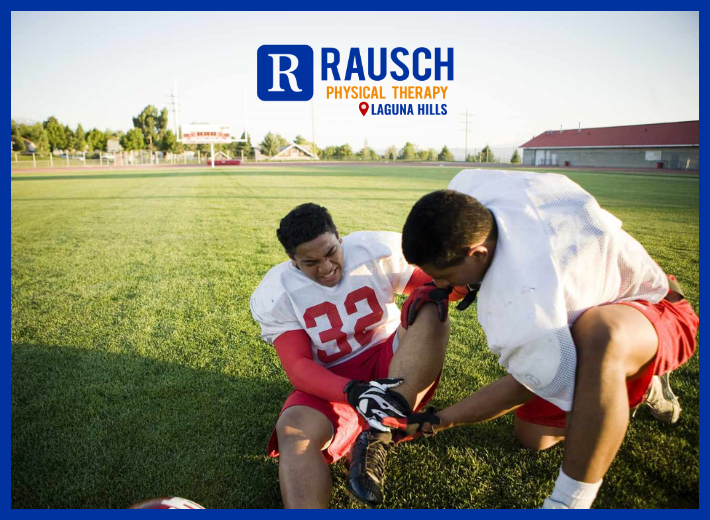When it comes to sports, staying healthy is just as important as playing hard. A serious injury can knock you out of the game for weeks—or even months—whether you’re a,
High School Football: What Are the Chances of Injury?
February 1, 2023 2:03 pm / Category: Rausch Physical Therapy

Youth football can be played safely if the athletes are coached and taught properly. To avoid further problems, keeping track of injuries and getting advice on treatment and prevention is essential. With the advice of your Rausch PT physical therapist, you and your teen can get to their best performance.
If a teen plays four years of high school football, chances are pretty good they’ll sustain an injury of some sort.
In fact, a high school athlete is about three times more likely to get hurt than competitors in other major sports.
In addition, that injury is more likely to be to their head or face. It’s also far more likely the injury will happen during a game instead of practice.
However, it is highly unlikely the injury will require surgery. And if it does, chances are it won’t have any serious lingering effects down the road.
Those are some of the conclusions that can be reached by sifting through statistics and talking with sports experts about high school football players.
Those experts add that advances in treatments, as well as injury prevention, are helping keep the number and severity of injuries down.
They also note the upside to participating in sports can make the risk of injury somewhat negligible.
“The benefits of participating in team sports far outweigh the risks,” Dr. Margot Putukian, F.A.C.S.M., director of athletic medicine at Princeton University, told Healthline.
Keeping track of injuries
Nearly 8 million teenagers now participate in high school sports.
That’s double the 4 million who participated in the 1971-72 school year.
For the past decade, the injuries sustained by those athletes have been monitored by the Colorado School of Public Health’s Program for Injury Prevention, Education & Research (PIPER).
The team, led by Professor Dawn Comstock, puts out an annual report on the injuries sustained in nine major high school sports.
The report has detailed statistics from 100 high schools across the country as well as estimated numbers for all high schools.
That data is gleaned from high school athletic officials who report their injuries to PIPER officials every Monday during their season.
The stats are broken down into number of injuries, the number of “athlete exposures,” and the rate of injuries for every 1,000 of those exposures.
Injuries are defined as any event that requires medical attention and keeps the athlete from participating in games or practices for at least one day. In addition, all fractures, concussions, dental injuries, and “heat events” are considered injuries.
Exposures are defined as one athlete participating in a single game or practice. For example, if 20 players get into a game, then that’s 20 exposures for that squad.
Football first in injuries
During the past decade, there has been an average of about 4 injuries per 1,000 athlete exposures in competition for all nine sports combined.
For high school football players, the rate during competition has ranged from 11.26 to 13.52 injuries per 1,000 athlete exposures.
The sport with the second highest rate is girls’ soccer, which hovers just above 5 injuries per 1,000 exposures every year.
For football, the injury rate during practice is right around 2 incidents per 1,000 exposures. That compares with an average rate of under 1.5 per 1,000 exposures for all nine sports combined.
Overall, the Colorado researchers estimate there are more than 500,000 injuries of some sort to high school football players nationwide every year.
In most years, less than 10 percent of those injuries require surgery.
In 2015, 28 percent of the football injuries were to a players’ head or face. Those included concussions.
Another 14 percent were knees, 11 percent were ankles, and 10 percent were shoulders.
About 68 percent of the injuries happened while players were tackling. Another 22 percent occurred while players were blocking.
Treatment and prevention
Safety concerns were raised last year when it was reported at least 11 high school football players died in the United States during the 2015 season.
Two years earlier, a study was published that concluded high school players had nearly twice the concussion rate as college players.
Still, experts said more sophisticated medical treatments and better prevention programs are holding the line on football injuries and reducing the severity of them.
Scott Sailor, president of the National Athletic Trainers’ Association (NATA), says athletes are also better physically prepared for contact sports than in decades past, helping cut down on the seriousness of injuries.
When surgery or other medical attention is required, he says, there are now safer and better techniques available.
Sailor also told Healthline it’s important for schools to have athletic trainers available, especially during competition. He said only 37 percent of U.S. high schools currently have a full-time athletic trainer.
Some of these precautions are also extending to football practice.
Putukian notes the National Collegiate Athletic Association (NCAA) now restricts contact practices to twice a week for football teams.
In addition, Ivy League teams don’t allow tackling in practices.
Putukian said some of the measures may be trickling down to high school teams.
She and Sailor also point out there are new coaching techniques to help reduce football injuries.
One of them is the Heads Up Football program overseen by USA Football. The program promotes tackling and blocking techniques designed to make the game safer.
Parental involvement
Sailor and Putukian agree parents need to take the lead when it comes to their child’s sports safety.
Putukian urges parents to scope out both a school’s program as well as the football coach before their child signs up.
For example, does the coach teach good techniques and put their athletes’ safety first?
“You need to do your homework,” she said.
NATA has launched the program At Your Own Risk, which provides information for parents, athletes, and school officials on sports safety.
Sailor says he feels all the measures being taken make football a relatively safe contact sport for high school students.
Rausch PT professionals have the skills and expertise you need to improve and restore your muscle to enjoy your sport to the fullest. Book your appointment today at 949-276-5401 and meet our experts. Join our Facebook community.
Reference: [https://www.healthline.com/health-news/likelihood-high-school-football-player-gets-injured#Parental-involvement]






